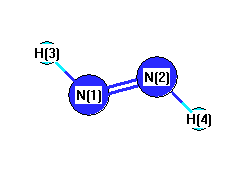Geometric Data

Point Group C2h
Internal coordinates
distances (r) in Å, angles (a) in degrees, dihedrals (d) in degrees
Cartesians
| Atom |
x (Å) |
y (Å) |
z (Å) |
| N1 |
0.0000 |
0.6260 |
0.0000 |
| N2 |
0.0000 |
-0.6260 |
0.0000 |
| H3 |
0.9867 |
0.9145 |
0.0000 |
| H4 |
-0.9867 |
-0.9145 |
0.0000 |
Atom - Atom Distances 
Distances in Å
| |
N1 |
N2 |
H3 |
H4 |
| N1 |
|
1.2520 | 1.0280 | 1.8294 |
| N2 |
1.2520 |
|
1.8294 | 1.0280 |
| H3 |
1.0280 | 1.8294 |
|
2.6906 |
| H4 |
1.8294 | 1.0280 | 2.6906 |
|
Calculated geometries
for N
2H
2+ (trans-diazene cation).
Experimental Bond Angles (degrees) from cartesians 
| atom1 |
atom2 |
atom3 |
angle |
|
atom1 |
atom2 |
atom3 |
angle |
| N1 |
N2 |
H4 |
106.300 |
|
N2 |
N1 |
H3 |
106.300 |
Bond descriptions
Examples: C-C single bond, C=C, double bond, C#C triple bond, C:C aromatic bond
| Bond Type |
Count |
| N=N |
1 |
| H-N |
2 |
Connectivity
| Atom 1 |
Atom 2 |
| N1 |
N2 |
| N1 |
H3 |
| N2 |
H4 |











